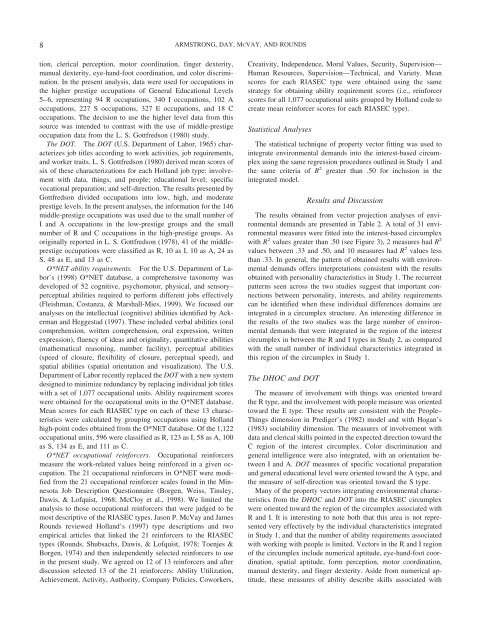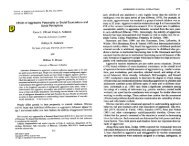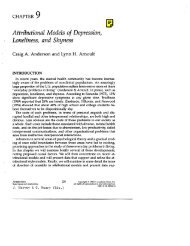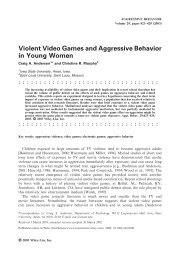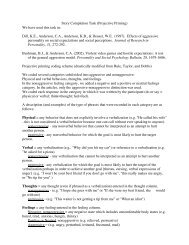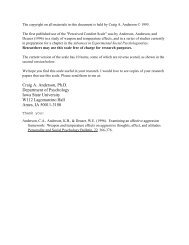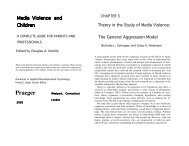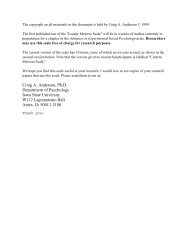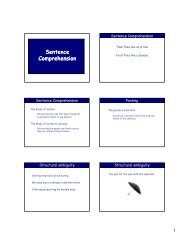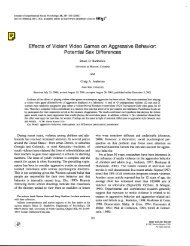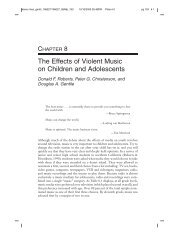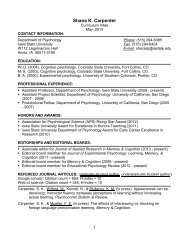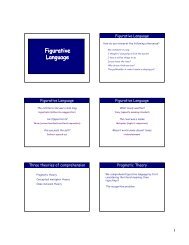Holland's RIASEC Model as an Integrative Framework for Individual ...
Holland's RIASEC Model as an Integrative Framework for Individual ...
Holland's RIASEC Model as an Integrative Framework for Individual ...
Create successful ePaper yourself
Turn your PDF publications into a flip-book with our unique Google optimized e-Paper software.
8 ARMSTRONG, DAY, MCVAY, AND ROUNDS<br />
tion, clerical perception, motor coordination, finger dexterity,<br />
m<strong>an</strong>ual dexterity, eye-h<strong>an</strong>d-foot coordination, <strong>an</strong>d color discrimination.<br />
In the present <strong>an</strong>alysis, data were used <strong>for</strong> occupations in<br />
the higher prestige occupations of General Educational Levels<br />
5–6, representing 94 R occupations, 340 I occupations, 102 A<br />
occupations, 227 S occupations, 327 E occupations, <strong>an</strong>d 18 C<br />
occupations. The decision to use the higher level data from this<br />
source w<strong>as</strong> intended to contr<strong>as</strong>t with the use of middle-prestige<br />
occupation data from the L. S. Gottfredson (1980) study.<br />
The DOT. The DOT (U.S. Department of Labor, 1965) characterizes<br />
job titles according to work activities, job requirements,<br />
<strong>an</strong>d worker traits. L. S. Gottfredson (1980) derived me<strong>an</strong> scores of<br />
six of these characterizations <strong>for</strong> each Holl<strong>an</strong>d job type: involvement<br />
with data, things, <strong>an</strong>d people; educational level; specific<br />
vocational preparation; <strong>an</strong>d self-direction. The results presented by<br />
Gottfredson divided occupations into low, high, <strong>an</strong>d moderate<br />
prestige levels. In the present <strong>an</strong>alyses, the in<strong>for</strong>mation <strong>for</strong> the 146<br />
middle-prestige occupations w<strong>as</strong> used due to the small number of<br />
I <strong>an</strong>d A occupations in the low-prestige groups <strong>an</strong>d the small<br />
number of R <strong>an</strong>d C occupations in the high-prestige groups. As<br />
originally reported in L. S. Gottfredson (1978), 41 of the middleprestige<br />
occupations were cl<strong>as</strong>sified <strong>as</strong> R, 10 <strong>as</strong> I, 10 <strong>as</strong> A, 24 <strong>as</strong><br />
S, 48 <strong>as</strong> E, <strong>an</strong>d 13 <strong>as</strong> C.<br />
O*NET ability requirements. For the U.S. Department of Labor’s<br />
(1998) O*NET datab<strong>as</strong>e, a comprehensive taxonomy w<strong>as</strong><br />
developed of 52 cognitive, psychomotor, physical, <strong>an</strong>d sensory–<br />
perceptual abilities required to per<strong>for</strong>m different jobs effectively<br />
(Fleishm<strong>an</strong>, Cost<strong>an</strong>za, & Marshall-Mies, 1999). We focused our<br />
<strong>an</strong>alyses on the intellectual (cognitive) abilities identified by Ackerm<strong>an</strong><br />
<strong>an</strong>d Heggestad (1997). These included verbal abilities (oral<br />
comprehension, written comprehension, oral expression, written<br />
expression), fluency of ide<strong>as</strong> <strong>an</strong>d originality, qu<strong>an</strong>titative abilities<br />
(mathematical re<strong>as</strong>oning, number facility), perceptual abilities<br />
(speed of closure, flexibility of closure, perceptual speed), <strong>an</strong>d<br />
spatial abilities (spatial orientation <strong>an</strong>d visualization). The U.S.<br />
Department of Labor recently replaced the DOT with a new system<br />
designed to minimize redund<strong>an</strong>cy by replacing individual job titles<br />
with a set of 1,077 occupational units. Ability requirement scores<br />
were obtained <strong>for</strong> the occupational units in the O*NET datab<strong>as</strong>e.<br />
Me<strong>an</strong> scores <strong>for</strong> each <strong>RIASEC</strong> type on each of these 13 characteristics<br />
were calculated by grouping occupations using Holl<strong>an</strong>d<br />
high-point codes obtained from the O*NET datab<strong>as</strong>e. Of the 1,122<br />
occupational units, 596 were cl<strong>as</strong>sified <strong>as</strong> R, 123 <strong>as</strong> I, 58 <strong>as</strong> A, 100<br />
<strong>as</strong> S, 134 <strong>as</strong> E, <strong>an</strong>d 111 <strong>as</strong> C.<br />
O*NET occupational rein<strong>for</strong>cers. Occupational rein<strong>for</strong>cers<br />
me<strong>as</strong>ure the work-related values being rein<strong>for</strong>ced in a given occupation.<br />
The 21 occupational rein<strong>for</strong>cers in O*NET were modified<br />
from the 21 occupational rein<strong>for</strong>cer scales found in the Minnesota<br />
Job Description Questionnaire (Borgen, Weiss, Tinsley,<br />
Dawis, & Lofquist, 1968; McCloy et al., 1998). We limited the<br />
<strong>an</strong>alysis to those occupational rein<strong>for</strong>cers that were judged to be<br />
most descriptive of the <strong>RIASEC</strong> types. J<strong>as</strong>on P. McVay <strong>an</strong>d James<br />
Rounds reviewed Holl<strong>an</strong>d’s (1997) type descriptions <strong>an</strong>d two<br />
empirical articles that linked the 21 rein<strong>for</strong>cers to the <strong>RIASEC</strong><br />
types (Rounds, Shubsachs, Dawis, & Lofquist, 1978; Toenjes &<br />
Borgen, 1974) <strong>an</strong>d then independently selected rein<strong>for</strong>cers to use<br />
in the present study. We agreed on 12 of 13 rein<strong>for</strong>cers <strong>an</strong>d after<br />
discussion selected 13 of the 21 rein<strong>for</strong>cers: Ability Utilization,<br />
Achievement, Activity, Authority, Comp<strong>an</strong>y Policies, Coworkers,<br />
Creativity, Independence, Moral Values, Security, Supervision—<br />
Hum<strong>an</strong> Resources, Supervision—Technical, <strong>an</strong>d Variety. Me<strong>an</strong><br />
scores <strong>for</strong> each <strong>RIASEC</strong> type were obtained using the same<br />
strategy <strong>for</strong> obtaining ability requirement scores (i.e., rein<strong>for</strong>cer<br />
scores <strong>for</strong> all 1,077 occupational units grouped by Holl<strong>an</strong>d code to<br />
create me<strong>an</strong> rein<strong>for</strong>cer scores <strong>for</strong> each <strong>RIASEC</strong> type).<br />
Statistical Analyses<br />
The statistical technique of property vector fitting w<strong>as</strong> used to<br />
integrate environmental dem<strong>an</strong>ds into the interest-b<strong>as</strong>ed circumplex<br />
using the same regression procedures outlined in Study 1 <strong>an</strong>d<br />
the same criteria of R 2 greater th<strong>an</strong> .50 <strong>for</strong> inclusion in the<br />
integrated model.<br />
Results <strong>an</strong>d Discussion<br />
The results obtained from vector projection <strong>an</strong>alyses of environmental<br />
dem<strong>an</strong>ds are presented in Table 2. A total of 31 environmental<br />
me<strong>as</strong>ures were fitted into the interest-b<strong>as</strong>ed circumplex<br />
with R 2 values greater th<strong>an</strong> .50 (see Figure 3), 2 me<strong>as</strong>ures had R 2<br />
values between .33 <strong>an</strong>d .50, <strong>an</strong>d 10 me<strong>as</strong>ures had R 2 values less<br />
th<strong>an</strong> .33. In general, the pattern of obtained results with environmental<br />
dem<strong>an</strong>ds offers interpretations consistent with the results<br />
obtained with personality characteristics in Study 1. The recurrent<br />
patterns seen across the two studies suggest that import<strong>an</strong>t connections<br />
between personality, interests, <strong>an</strong>d ability requirements<br />
c<strong>an</strong> be identified when these individual differences domains are<br />
integrated in a circumplex structure. An interesting difference in<br />
the results of the two studies w<strong>as</strong> the large number of environmental<br />
dem<strong>an</strong>ds that were integrated in the region of the interest<br />
circumplex in between the R <strong>an</strong>d I types in Study 2, <strong>as</strong> compared<br />
with the small number of individual characteristics integrated in<br />
this region of the circumplex in Study 1.<br />
The DHOC <strong>an</strong>d DOT<br />
The me<strong>as</strong>ure of involvement with things w<strong>as</strong> oriented toward<br />
the R type, <strong>an</strong>d the involvement with people me<strong>as</strong>ure w<strong>as</strong> oriented<br />
toward the E type. These results are consistent with the People–<br />
Things dimension in Prediger’s (1982) model <strong>an</strong>d with Hog<strong>an</strong>’s<br />
(1983) sociability dimension. The me<strong>as</strong>ures of involvement with<br />
data <strong>an</strong>d clerical skills pointed in the expected direction toward the<br />
C region of the interest circumplex. Color discrimination <strong>an</strong>d<br />
general intelligence were also integrated, with <strong>an</strong> orientation between<br />
I <strong>an</strong>d A. DOT me<strong>as</strong>ures of specific vocational preparation<br />
<strong>an</strong>d general educational level were oriented toward the A type, <strong>an</strong>d<br />
the me<strong>as</strong>ure of self-direction w<strong>as</strong> oriented toward the S type.<br />
M<strong>an</strong>y of the property vectors integrating environmental characteristics<br />
from the DHOC <strong>an</strong>d DOT into the <strong>RIASEC</strong> circumplex<br />
were oriented toward the region of the circumplex <strong>as</strong>sociated with<br />
R <strong>an</strong>d I. It is interesting to note both that this area is not represented<br />
very effectively by the individual characteristics integrated<br />
in Study 1, <strong>an</strong>d that the number of ability requirements <strong>as</strong>sociated<br />
with working with people is limited. Vectors in the R <strong>an</strong>d I region<br />
of the circumplex include numerical aptitude, eye-h<strong>an</strong>d-foot coordination,<br />
spatial aptitude, <strong>for</strong>m perception, motor coordination,<br />
m<strong>an</strong>ual dexterity, <strong>an</strong>d finger dexterity. Aside from numerical aptitude,<br />
these me<strong>as</strong>ures of ability describe skills <strong>as</strong>sociated with


